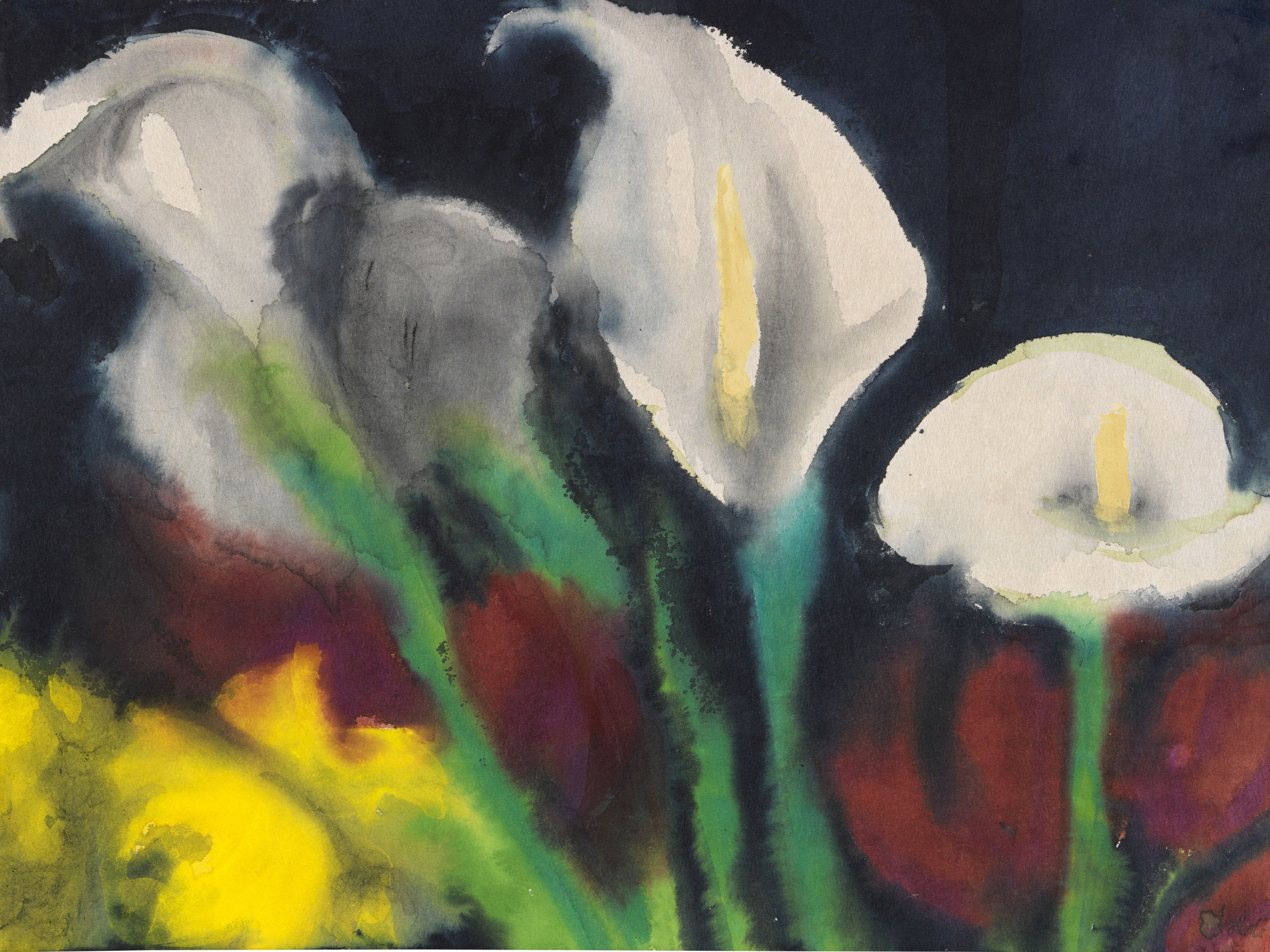Emil Nolde - Weiße Calla über roten und gelben Blüten, ca.1925-30
EMIL NOLDE
Weiße Calla über roten und gelben Blüten, Um 1925/1930.
Aquarell
Object description
White calla over red and yellow flowers . Around 1925/1930.
Watercolor.
Signed lower right. On Japan. 34.3 x 45.8 cm (13.5 x 18 in), the full sheet.
With a photo expertise from Prof. Dr. Martin Urban, Seebüll Ada and Emil Nolde Foundation, dated April 25, 1993, with additional handwritten confirmation from Dr. Manfred Reuther, Ada and Emil Nolde Foundation, Seebüll, from July 8, 2008. The work is registered in the archive of the Nolde Foundation.
PROVENANCE: Villa Grisebach Auctions, Berlin, 37th auction, selected works, May 27, 1994, cat.-no. 25, with full-page illus.
Private collection Baden-Würtemberg (acquired from aforementioned in 1994, in family possession since).
"The blooming colors of the flowers and the purity of these colors, I loved them. I loved the flowers in their fate: sprouting, blooming, glowing brightly, exhilarating, sloping, withering, ending discarded in the pit. Our human fate is not always the same consistent and beautiful. "
Emil Nolde, quoted from: Martin Urban, Emil Nolde - Flowers and Animals. Watercolors and drawings, Cologne 1965, p. 7f.
Watercolor.
Signed lower right. On Japan. 34.3 x 45.8 cm (13.5 x 18 in), the full sheet.
With a photo expertise from Prof. Dr. Martin Urban, Seebüll Ada and Emil Nolde Foundation, dated April 25, 1993, with additional handwritten confirmation from Dr. Manfred Reuther, Ada and Emil Nolde Foundation, Seebüll, from July 8, 2008. The work is registered in the archive of the Nolde Foundation.
PROVENANCE: Villa Grisebach Auctions, Berlin, 37th auction, selected works, May 27, 1994, cat.-no. 25, with full-page illus.
Private collection Baden-Würtemberg (acquired from aforementioned in 1994, in family possession since).
"The blooming colors of the flowers and the purity of these colors, I loved them. I loved the flowers in their fate: sprouting, blooming, glowing brightly, exhilarating, sloping, withering, ending discarded in the pit. Our human fate is not always the same consistent and beautiful. "
Emil Nolde, quoted from: Martin Urban, Emil Nolde - Flowers and Animals. Watercolors and drawings, Cologne 1965, p. 7f.
essay
The "Brücke" artist Emil Nolde discovered the potential of color for his painting in the summer of 1906 in a series of garden and flower pictures. In the following two years a total of 28 paintings of this type were created in quick succession, some of which were presented to the public for the first time in 1908 in the Paul Cassirer Gallery in Berlin and, due to the boldness of their color effects, initially provoked extremely divided reactions in the established art world. Here Nolde spreads the dense staggering of the plants like a carpet over the entire canvas; he is not interested in the documentary study of the plants, but rather in the simultaneous effect of the bright colors, which from then on should become the central expression of his creations and the meaning of the contour is increasingly being pushed into the background. It is therefore an artistically necessary step that from 1910 onwards Nolde made his famous flower arrangements in the form of watercolors on absorbent Japan, which he moistened before applying paint. This "wet-on-wet" technique meets his desire for immediacy and spontaneity in dealing with color. In contact with the damp paper, the color develops a dynamic life of its own, it melts, blurs, spreads and soaks the paper. Nolde is a master of this process and he confidently sets limits to the freedom of color by making use of the progressive drying process of the paper and, in some cases, using surfaces that are contoured with a brush on the dried paper. The result is works of extraordinary luminosity and depth of color. What is also special in our expressive composition "White calla over red and yellow flowers" is the strong, almost abstract stylization of the forms. Nolde has seldom captured the eccentric calla flowers in his watercolors, which he staged here in all their luminosity and strength against a black background [JS]

Comments
Post a Comment